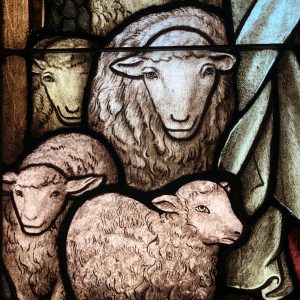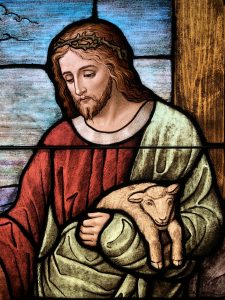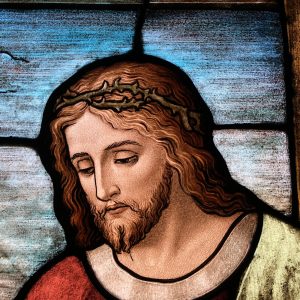
A Sheepish Relationship
We have several unique pieces of art in the sanctuary at Hood Memorial Christian Church. And today, on Good Shepherd Sunday, I want to point out to you the Good Shepherd window.
Many sermons and poems and songs about the Good Shepherd. They all have a message. And our window has some messages in it. Some of which may be hidden to you right now. Like most pastors and painters and poets, our window suggests that the Good Shepherd is about relationship. But not in the way you might think!
Think with me for a bit on some of the unique details of this window:
 Flock of sheep
Flock of sheep
When we think about our relationship with Jesus it is often our individual relationship with Jesus. And the good shepherd is about relationship with Jesus, but not in the way you might think. It’s not just about your individual, personal relationships with Jesus. It’s more.
There is a saying (may or may not be from Alexander the Great):
I’m not afraid of an army of lions led by a sheep. But I’m terrified of an army of sheep led by a lion.
This saying tells us a couple of things:
- sheep are not leaders; lions are
- lions don’t work well in large numbers; sheep do
Alone, sheep can’t do much. Their power comes in numbers. They are made for community. And with the right leader, they are an unstoppable force.
In fact, it is the flock which makes them so strong. It protects them. Alone sheep are no match for the predators of the world. But together – especially with the right leader (a really good shepherd) – they are safe, strong, and can survive!
The shepherd and his flock is not simply about your individual relationship with Jesus. The good shepherd is about us, together, our common relationship to Jesus, our relationship to Jesus as a church – not in isolation from one another, but together as we live with and for one another protecting one another from the thieves and bandits of the world.
NOTE: And there are other flocks as well, but more on that in a bit.
Good shepherd is about relationship. But not in the way you might think.
 Jesus holding sheep
Jesus holding sheep
Paintings and stained glass of the good shepherd often depict Jesus with a lamb around his neck. And there have been attempts to explain what that image is all about (probably because it’s not so common to carry sheep around your neck, at least from my research).
A myth been around for about 60-70 years of Jesus as this rigid disciplinarian. It goes like this:
Sheep tend to stray. So shepherds would have to discipline lambs that would constantly stray. The shepherd would use his rod to break the leg of a wandering lamb. After binding the break, the shepherd would carry the lamb on his shoulders while the wound healed. During the healing process, the lamb needed the shepherd to provide food, transportation and protection. Consequently the lamb learned to trust the shepherd. And after it was healed completely, the lamb was fiercely loyal to the shepherd and would no longer stray.
I don’t know how that comes across to you. Maybe it’s nice to think about Jesus doing something to pull you in and get you to trust him. I personally think it is kinda sick to break someone’s legs so that they’re forced to rely on you. It’s manipulation. It’s the kind of action of an abusive person who wants to force a victim into depending on him so he can have his way. It’s not really an image of free will at all, is it?
Now you’ll think twice the next time you see the image of Jesus with a lamb on his shoulders!
And here’s the truth
- There is no historical evidence of this myth.
- It makes no sense….not practical, very dangerous to the sheep’s health. It’s life threatening.
But someone back in the 1950s told an anecdotal story about a shepherd breaking a sheeps legs and the idea has taken off amongst pastors and been used as an analogy even when there is no evidence for it.
The story says that Christ knows the sheep, and that they know him. He doesn’t need to break their legs. Jesus is a shepherd who cultivated a relationship with his sheep. So when he finds them they’ll follow him because they know his voice, because he knows how to talk to them, because he knows knows what to say to guide them from one place to another.
We are Jesus’ sheep. Jesus doesn’t break our legs. Jesus knows us. He doesn’t just know our name or our history. It’s not simply a cognitive knowledge. Jesus know us intimately and a best friend, as a father, as a mother knows her child. It’s a knowledge of relationship based on honest love and compassionate care and authentic trust…just like what you see pictured in our window. Jesus intimately holds the sheep in his left arm near his heart, wrapping it in his own cloak, loving us as a shepherd loves his flock.
Jesus relationship as the Good Shepherd is not about manipulation. It’s about intimacy.
So, the Good shepherd is about relationship. But not in the way you might think.
Door or gateway
There are Christians who think about Jesus to relationship in terms of heaven and hell relationship. Their relationship to Jesus is based on who is in and who is out. It’s based on a fear of eternity. The message is Jesus letting some in to heaven because they believe, but those who don’t get shut out. The door, the gate gets closed in their face for eternity.
But the shepherd’s goal is to keep ALL the sheep together, to keep them from scattering, to bring them all to a safe place.
It’s a metaphor for the prayer which we hear later in john 17:21 – “that they may all be one” – a prayer of unity and oneness, or bringing people together.
It’s important to note that in the scripture Jesus speaks about other flocks:
I have other sheep that don’t belong to this sheep pen. I must lead them too. They will listen to my voice and there will be one flock, with one shepherd.
This is a great passage especially for we Disciples of Christ. It pushes us to welcome other sheep – sheep who may not call themselves Christian but respond to the voice of the shepherd. And make no mistake that there are plenty of people out there that may not be in this flock but still hear and respond to the voice of Jesus, other religious traditions who may not understand Jesus as messiah but still respond to his voice as a prophet and great teacher, who look to the way of Jesus as a model for living. Some of these folks have been raised in the church and drifted away because although they loved
Jesus Christ, they didn’t love Christians. Their experience was that Christians don’t act much like Christ.
The good shepherd is not about who is in and who is out, not about separation and division, not about doors being closed in faces. It’s about gathering all God’s sheep together. It’s about oneness and unity.
So, Good shepherd is about relationship. But not in the way you might think.
 Jesus head turned down
Jesus head turned down
Christians have most often viewed the good shepherd as an image exalting Christ. But when you look at it in context of John, Jesus offers this image only to call out the Pharisees for being bad shepherds – so bad that they aren’t acting like shepherds at all but more like Bandits and thieves and strangers to the sheep. People who do not know the sheep, have no intimate relationship with the sheep. Leaders who care more about themselves than their sheep.
I think Jesus head tilted down in our window is symbolic of this aspect of the story. Jesus goal was not to exalt himself, to say he was good while calling others bad. Rather he was pointing out what was wrong with the religious leaders of his day and saying the model shepherd acts differently.
Maybe there is not much difference in the effect of Jesus words because he clearly does name himself as the model shepherd. But I think context makes a difference. Jesus is not gloating or boasting about himself. He is calling out the poor behavior of the Pharisees and calling them in to act like good shepherds.
The good shepherd isn’t just about lifting Jesus up. It’s about a model relationship. The model shepherd is a servant of the sheep, not arrogant or boastful or prideful. The model shepherd shows others the best way to be a shepherd, calls others to care for sheep and put the sheep before themselves.
And that brings us to one last observation…
You see, the Good shepherd is about relationship. But not in the way you might think.
Crown of thorns on Jesus head
The crown of thorns is a reminder that As the story says, The shepherd will lay down his life for his sheep.
In the story, lay down his life is meant to be a comparison…specifically to the Pharisees. You have to go back a bit. And when you do you read about a blind man….and Jesus healing him by spitting in dirt and rubbing it on his eyes – a crazy story! (Hock a loogie and rub it on someone’s face!)
The Pharisees see Jesus as opposition to them. Jesus breaks religious laws in the name of God’s love and grace. The pharisees at most every turn in scripture come across as caring more about religious laws than people. Jesus is quite the opposite. The Pharisees care more about their position and status than the people they serve. Jesus is quite the opposite.
In fact, as the story says, Jesus is willing to lay down his life for his sheep. Jesus is willing to die for sheep. Pay attention to the window though. This is not the resurrected Jesus who died (past tense)for you. How do I know? Well, a couple things:
First, colors matter in stained glass. What color is Jesus wearing?
Red.
Red is used to represent humanity and the saving nature of the resurrection. It is the color of blood and therefor symbolizes human life. White on the other hand is the color of purity, divinity and heavenly life. If this were the resurrected. Christ, he would be in a white robe, not red. The red signifies this is not the resurrected Jesus but the living human Jesus not yet sacrificed one the cross.
So what? Well, the point is this is the earthly Jesus. And to get to number 2, it’s the earth Jesus pulled right off the cross with his crown of thorns….not yet dead, but willing to die for you.
Jesus is not our shepherd in a post-resurrection way. Jesus is our shepherd willing to lay down his life right now. This is not the teacher Jesus or miracle performer Jesus. And it’s not the resurrected Jesus. Instead, the artist of our window pulls Jesus off the cross and paints him as the shepherd with his crown of thorns. The crown of thorns is about what kind of living shepherd Jesus is right now for you and me today.
You see, in this passage Jesus is not simply the Good Shepherd because he already died for you. He is the good shepherd because he is alive and willing to die right now for you!
Good shepherd is about relationship. But not in the way you might think.
The good shepherd is all about relationship…..
- Not simply individual, but community, a relationship that encompass all of us
- Not abuse or manipulation, but caring intimacy and loving compassion
- Not about who is in or out, but about gathering all sheep in oneness and unity
- Not about exaltation of a great leader. It’s about serving
- Not about self-serving legalism, but about love that serves other, about putting the other before the self
- Not simply about someone who died for you a long time ago, but about one who is alive and walking with you guiding you and willing to die for you right now
And if you ask me, that kind of relationship is a relationship worth having in your life.



